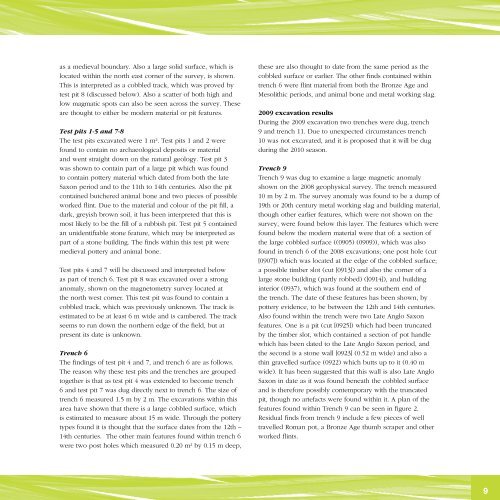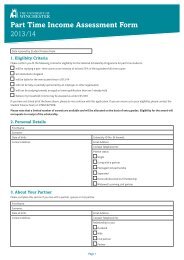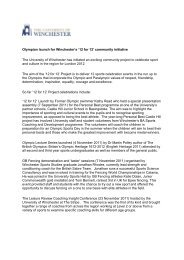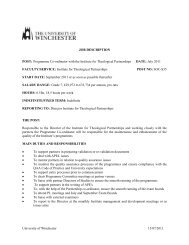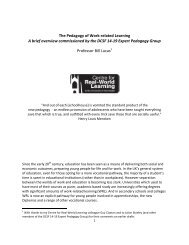alfred 2 - University of Winchester
alfred 2 - University of Winchester
alfred 2 - University of Winchester
You also want an ePaper? Increase the reach of your titles
YUMPU automatically turns print PDFs into web optimized ePapers that Google loves.
as a medieval boundary. Also a large solid surface, which is<br />
located within the north east corner <strong>of</strong> the survey, is shown.<br />
This is interpreted as a cobbled track, which was proved by<br />
test pit 8 (discussed below). Also a scatter <strong>of</strong> both high and<br />
low magmatic spots can also be seen across the survey. These<br />
are thought to either be modern material or pit features.<br />
Test pits 1-5 and 7-8<br />
The test pits excavated were 1 m². Test pits 1 and 2 were<br />
found to contain no archaeological deposits or material<br />
and went straight down on the natural geology. Test pit 3<br />
was shown to contain part <strong>of</strong> a large pit which was found<br />
to contain pottery material which dated from both the late<br />
Saxon period and to the 11th to 14th centuries. Also the pit<br />
contained butchered animal bone and two pieces <strong>of</strong> possible<br />
worked flint. Due to the material and colour <strong>of</strong> the pit fill, a<br />
dark, greyish brown soil, it has been interpreted that this is<br />
most likely to be the fill <strong>of</strong> a rubbish pit. Test pit 5 contained<br />
an unidentifiable stone feature, which may be interpreted as<br />
part <strong>of</strong> a stone building. The finds within this test pit were<br />
medieval pottery and animal bone.<br />
Test pits 4 and 7 will be discussed and interpreted below<br />
as part <strong>of</strong> trench 6. Test pit 8 was excavated over a strong<br />
anomaly, shown on the magnetometry survey located at<br />
the north west corner. This test pit was found to contain a<br />
cobbled track, which was previously unknown. The track is<br />
estimated to be at least 6 m wide and is cambered. The track<br />
seems to run down the northern edge <strong>of</strong> the field, but at<br />
present its date is unknown.<br />
Trench 6<br />
The findings <strong>of</strong> test pit 4 and 7, and trench 6 are as follows.<br />
The reason why these test pits and the trenches are grouped<br />
together is that as test pit 4 was extended to become trench<br />
6 and test pit 7 was dug directly next to trench 6. The size <strong>of</strong><br />
trench 6 measured 1.5 m by 2 m. The excavations within this<br />
area have shown that there is a large cobbled surface, which<br />
is estimated to measure about 15 m wide. Through the pottery<br />
types found it is thought that the surface dates from the 12th –<br />
14th centuries. The other main features found within trench 6<br />
were two post holes which measured 0.20 m² by 0.15 m deep,<br />
these are also thought to date from the same period as the<br />
cobbled surface or earlier. The other finds contained within<br />
trench 6 were flint material from both the Bronze Age and<br />
Mesolithic periods, and animal bone and metal working slag.<br />
2009 excavation results<br />
During the 2009 excavation two trenches were dug, trench<br />
9 and trench 11. Due to unexpected circumstances trench<br />
10 was not excavated, and it is proposed that it will be dug<br />
during the 2010 season.<br />
Trench 9<br />
Trench 9 was dug to examine a large magnetic anomaly<br />
shown on the 2008 geophysical survey. The trench measured<br />
10 m by 2 m. The survey anomaly was found to be a dump <strong>of</strong><br />
19th or 20th century metal working slag and building material,<br />
though other earlier features, which were not shown on the<br />
survey, were found below this layer. The features which were<br />
found below the modern material were that <strong>of</strong>: a section <strong>of</strong><br />
the large cobbled surface ((0905) (0909)), which was also<br />
found in trench 6 <strong>of</strong> the 2008 excavations; one post hole (cut<br />
[0907]) which was located at the edge <strong>of</strong> the cobbled surface;<br />
a possible timber slot (cut [0913]) and also the corner <strong>of</strong> a<br />
large stone building (partly robbed) ([0914]), and building<br />
interior (0937), which was found at the southern end <strong>of</strong><br />
the trench. The date <strong>of</strong> these features has been shown, by<br />
pottery evidence, to be between the 12th and 14th centuries.<br />
Also found within the trench were two Late Anglo Saxon<br />
features. One is a pit (cut [0925]) which had been truncated<br />
by the timber slot, which contained a section <strong>of</strong> pot handle<br />
which has been dated to the Late Anglo Saxon period, and<br />
the second is a stone wall [0923] (0.52 m wide) and also a<br />
thin gravelled surface (0922) which butts up to it (0.40 m<br />
wide). It has been suggested that this wall is also Late Anglo<br />
Saxon in date as it was found beneath the cobbled surface<br />
and is therefore possibly contemporary with the truncated<br />
pit, though no artefacts were found within it. A plan <strong>of</strong> the<br />
features found within Trench 9 can be seen in figure 2.<br />
Residual finds from trench 9 include a few pieces <strong>of</strong> well<br />
travelled Roman pot, a Bronze Age thumb scraper and other<br />
worked flints.<br />
9


